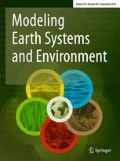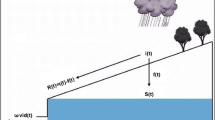Abstract
In this study, Hydrological Simulation Program-FORTRAN (HSPF) is used to investigate rainfall-runoff process in Taleghan watershed, northern Iran. Despite the high accuracy of the model, the lack of rainfall data at short time scales (hour and less than hour) restricted implementation of the model especially for long time simulations. Some studies use simple division for daily rainfall disaggregation into the hourly values to provide data requirements of HSPF model. In simple division, each rainfall event is divided into 24 pulse stochastically and the peak flows may not properly being simulated due to the lower rainfall intensities. In this study, random parameter Bartlett–Lewis rectangular pulse (BLRP) model was implemented to disaggregate daily rainfall time series into the hourly values and the results compared with that of simple division. In BLRP model, parameters of the model calibrated against the 1, 24 and 48 h mean, variance, lag1 auto covariance and proportion dry of observed rainfall. The calibrated model was then implemented to disaggregate daily rainfall data into the hourly values. To compare two disaggregation approaches, daily stream flow simulation by HSPF model is initialized in 2 scenarios by applying the hourly rainfall data resulted from two disaggregation methods. The results indicated that while using the simple division method leads to the underestimation of peak flows, using the BLRP model improved peak flow simulations. This study indicated usability of the BLRP model for rainfall disaggregation in arid and semi-arid regions with limited fine scale precipitation data availability.













Similar content being viewed by others
References
Abdellatif M, Atherton W, Alkhaddar R (2013) Application of the stochastic model for temporal rainfall disaggregation for hydrological studies in north western England. J Hydroinf 15(2):555–567. doi:10.2166/hydro.2012.090
Alavinia M (2009) Comparison between HSPF and SWAT models for sediment (Case study:Abro watershed). Tarbiat Modarres University, Tehran
Albek M, Ogutveren UB, Albek E (2006) Hydrological modeling of Seydi Suyu watershed (Turkey) with HSPF. J hydrol 285:260–271
Amirhossien F, Alireza F, Kazem J, Mohammadbagher S (2015) A comparison of ANN and HSPF models for runoff simulation in Balkhichai River Watershed, Iran. AJCC 4:203–216. 10.4236/ajcc.2015.43016
Aqua Terra Consultants (1996) HSPF data structure: the operation status vector (OSV). Aqua Terra Consultants, Mountain View (Unpublished)
Arnold JG, Srinivasin R, Muttiah RS, Williams JR (1998) Large area hydrologic modeling and assessment: Part I. Model development. J Am Water Resour Assoc 34(1):73–89
Bennett SJ, Bishop TFA, Vervoort RW (2013) Using SWAP to quantify space and time related uncertainty in deep drainage model estimates: a case study from northern NSW, Australia. Agr Water Manag 130: 142–153.
Bicknell BR, Imhoff JC, Kittle JRJL, Donigian JRAS and Johanson RC (1997) Hydrological Simulation Program-FORTRAN, user’s manual for release 11: EPA/600/R-97/080. US Environmental Protection Agency, National Exposure Research Laboratory, Athens, GA
Bicknell BR, Imhoff JC, Kittle JRJL, Jobes TH, Donigian JRAS (2005) Hydrological Simulation Program-FORTRAN (HSPF). User’s manual for release 12.2. US EPA National Exposure Research Laboratory, Athens, GA, in cooperation with US Geological Survey, Water Resources Division, Reston, VA
Bo Z, Islam S, Eltahir EAB (1994) Aggregation–disaggregation properties of a stochastic rainfall model. Water Resour Res 30(12):3423–3435. doi:10.1029/94WR02026
Chen YD, McCutcheon SC, Carsel RF, Donigian ASJR, Cannell JP (1995) Validation of HSPF for the water balance simulation of the Upper Grande Ronde watershed, Oregon, USA. Man’s influence on freshwater ecosystems and water use (Proceedings of a Boulder Symposium), July, 1995. IAHS Publ. No. 230, 1995
Choi J, Sokolofsky SA, Olivera F (2008) Hourly disaggregation of hourly rainfall in Texas using measured hourly precipitation at other locations. J Hydrol Eng 13(6):476–487
Cowpertwait PSP, Lockie T, Davies MD (2006) A stochastic spatial-temporal disaggregation model for rainfall. J Hydrol NZ. 45:1–12
Debele B, Srinivasan R, Yves Parlange J (2007) Accuracy evaluation of weather data generation and disaggregation methods at finer timescales. Adv Water Resour 30:1286–1300. doi:10.1016/j.advwatres.2006.11.009
Donigian AS, Crawford NH (1976) Modelling nonpoint pollution from the land surface. EPA/600/3-76-083, Environmental Research Laboratory, Athens
Donigian AS, Davis HH. 1978. User’s manual for agricultural runoff management (ARM) model. EPA-600/3-78-080, USEPA, Athens, GA, 112 p
Donigian JRAS, Huber WC (1991) Modeling of nonpoint source water quality in urban and non-urban areas. EPA-600/3-91-039, USEPA, Athens, GA, 78 p
Donigian JRAS, Bicknell BR, Imhoff JC (1995) Hydrological Simulation Program-FORTRAN (HSPF). In: Singh VP (ed) Computer models of watershed hydrology. Water Resources Publications Highlands Ranch, pp 395–442
Dousti M, Shahedi K, Habibnejad Roshan M, Miryaghoubzadeh MR (2014) Using IHACRES semi-conceptual model to simulate daily flow (Case study: Tamar basin). JWSC 21(2):277–299
Engida AN, Esteves M (2011) Characterization and disaggregation of daily rainfall in the Upper Blue Nile Basin in Ethiopia. J Hydrol 399:226–234. doi:10.1016/j.jhydrol.2011.01.001
FAO (1978) Report on the agro-ecological zones project. World Soil Resources Report n. 48FAO, Rome
FAUT (1993) General investigation of Taleghan basin: hydrometeology and climatology report. 2:20–25
Feldman AD (2000) Hydrologic Modeling System HEC–HMS, technical reference manual. US Army Corps of Engineers, Hydrologic Engineering Center, HEC, Davis, CA, USA
Fontaine TA, Jacomino VMF (1997) Sensitivity analysis of simulated contaminated sediment transport. J Am Water Resour As 33(2):313–326
Hamon RW (1961) Estimating potential evapotranspiration. Proc Am Soc Civil Eng J Hydraul Div 87:107–120
Hingray B, Monbaron E, Jarrar I, Favre AC, Consuegra D, Musy A (2002) Stochastic generation and disaggregation of hourly rainfall series for continuous hydrological modelling and flood control reservoir design. Water Sci Technol 45:113–119
Hoseini M (2011) Effect of land use changes on water balance and suspended sediment yield of Taleghan catchment, Iran. PhD Thesis, UPM, Serdang, Malaysia
Hydrocomp Inc (1977) Hydrocomp water quality operations manual. Hydrocomp, Inc, Palo Alto
Im SJ, Brannan KM, Mostaghimi S, Kim SM (2007) Comparison of HSPF and SWAT models performance for runoff and sediment yield prediction. J Environ Sci Heal A 42(11):1561–1570
Iskra I, Droste R (2007) Application of non-linear automatic optimization techniques for calibration of HSPF. Water Environ Res 79(6):647–659
Jebari S (2009) Water erosion modelling using fractal rainfall disaggregation, a study in semiarid Tunisia. Lund Institute of Technology, Lund University, Sweden
Johnson MS, Coon WF, Mehta VK, Steenhuis TS, Brooks ES, Boll J (2003) Application of two hydrologic models with different runoff mechanisms to a hillslope dominated watershed in the northeastern US: a comparison of HSPF and SMR. J Hydrol 284(1–4):57–76
Kossieris P, Makropoulos C, Onof C, Koutsoyiannis D (2016) A rainfall disaggregation scheme for sub-hourly time scales: coupling a Bartlett–Lewis based model with adjusting procedures. J Hydrol. doi:10.1016/j.jhydrol.2016.07.015
Koutsoyiannis D (1994) A stochastic disaggregation method for design storm and flood synthesis. J Hydrol 156:193–225. doi:10.1016/0022-1694(94)90078-7
Koutsoyiannis D, Foufoula-Georgiou E (1993) A scaling model of a storm hyetograph. Water Resour Res 29:2345–2361
Koutsoyiannis D, Onof C (2001) Rainfall disaggregation using adjusting procedures on a Poisson cluster model. J Hydrol 246:109–122. doi:10.1016/S0022-1694(01)00363-8
Kozanis S, Christofides A, Mamassis N, Efstratiadis A, Koutsoyiannis D (2010) Hydrognomon—open source software for the analysis of hydrological data. Geophysical research abstracts, vol 12. European Geosciences Union, Vienna, p 12419. doi:10.13140/RG.2.2.21350.83527
Laroche A, Gallichaud J, Lagace R, Pesant A (1996) Simulating atrazine transport with HSPF in an agricultural watershed. J Environ Eng ASCE 122(7):622
Lian YQ, Chan I, Xie H, Demissie M (2010) Improving HSPF modeling accuracy from FTABLES: a case study for the Illinois River Basin. J Hydrol Eng ASCE 15(8):642–650
Mishra A, Kar S, Raghuwanshi NS (2009) Modeling nonpoint source pollutant losses from a small watershed using HSPF model. J Environ Eng ASCE 135(2):92–100
Nasiri Saleh F, Miyazaki S, Yoshimura K, Kanae S, Oki T (2006) Applicability of down scaled global data for Ardebil Area in Iran. Proceeding of 3rd APHW Conference, Bankok, Thailand, ST1-01-A07, pp 335–340
Nasr A, Bruen M, Jordan P, Moles R, Kiely G, Byrne P (2007) A comparison of SWAT, HSPF and SHETRAN/GOPC for modelling phosphorus export from three catchments in Ireland. Water Resour 41(5):1065–1073.
Pui A, Sharma A, Mehrotra R, Sivakumar B, Jeremiah E (2012) A comparison of alternatives for daily to sub-daily rainfall disaggregation. J Hydrol 470–471:138–157. doi:10.1016/j.jhydrol.2012.08.041
Rango A, Martinec J (1995) Revisiting the degree-day method for snowmelt computations. Water Resour Bull 31(4):657–669
Razavizadeh S, Salajegheh A, Khalighi S, Jafari M (2013) Effects of land use changes on flood characteristics using the HEC–HMS model (Case study: Taleghan watershed). JRWM 66(3):373–386.
Rodríguez-Iturbe I, de Power BF, Valdés JB (1987) Rectangular pulses point process models for rainfall: analysis of empirical data. J Geophys Res 92:9645–9656
Rostamian R, Jaleh A, Afyuni M, Mousavi F, Heidarpour M, Jalalian A, Abbaspour KC (2008) Application of SWAT model for estimating runoff and sediment in two mountaineous basins in central Iran. Hydrol Sci J 53(5):977–988
Ryu JH (2009) Application of HSPF to the distributed model intercomparison project: case study. J Hydrol Eng 14(8):847–857
Sadeghi SH, Ghasemieh H, Sadatinejad SJ (2015) Performance evaluation of IHACRES hydrological model in wet areas (Case study: Navrud Basin, Gillan). JWSS 19(73): 73–82.
Saleh A, Du B (2004) Evaluation of SWAT and HSPF within BASINS program for the upper North Bosque River watershed in Central Texas. Trans ASAE 47(4): 1039–1049.
Segond ML, Onof C, Wheater HS (2006) Spatial–temporal disaggregation of daily rainfall from a generalized linear model. J Hydrol 331:674–689. doi:10.1016/j.jhydrol.2006.06.019
Segond ML, Neokleous N, Makropoulos C, Onof C, Maksimovic C (2007) Simulation and spatio-temporal disaggregation of multi-site rainfall data for urban drainage applications. Hydrol Sci J 52:917–935. doi:10.1623/hysj.52.5.917
Singh J, Knapp HV, Arnold JG, Misganaw D (2005) Hydrological modeling of the Iroquois river watershed using HSPF and SWAT. J Am Water Resour As 41(2):343–360
Singh Vijay P (1997) Kinematic wave modeling in water resources. Wiley, New York
Soltani S, Saboohi R, Yaghmaei L (2012) Rainfall and rainy days trend in Iran. Clim Change 110:187–213
Taylor KE (2001) Summarizing multiple aspects of model performance in a single diagram. J Geophys Res 106:7183–7192
Viessman W, Lewis GL, Knapp JW (1989) Introduction to hydrology, 3rd edn. Harper and Row, New York
Zarei M, Ghanbarpour MR, Habibnezhad Roshan M, Shahedi K (2009) Streamflow simulation using IHACRES rainfall-runoff model (Case study: Kasilian Catchment). JWMSEI 3(8):11–20
Acknowledgements
The authors would like to thank Iran Ministry of Power for their kind help and technical support for providing the data for this study.
Author information
Authors and Affiliations
Corresponding author
Rights and permissions
About this article
Cite this article
Dodangeh, E., Shahedi, K., Solaimani, K. et al. Usability of the BLRP model for hydrological applications in arid and semi-arid regions with limited precipitation data. Model. Earth Syst. Environ. 3, 539–555 (2017). https://doi.org/10.1007/s40808-017-0312-1
Received:
Accepted:
Published:
Issue Date:
DOI: https://doi.org/10.1007/s40808-017-0312-1




